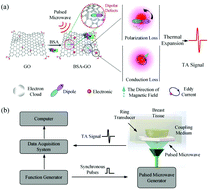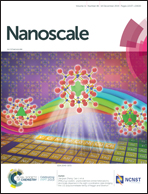Increasing dielectric loss of a graphene oxide nanoparticle to enhance the microwave thermoacoustic imaging contrast of breast tumor†
Abstract
Microwave-induced thermoacoustic imaging (MTAI) utilizes the high dielectric contrast of tissues in the microwave range, and, combined with the high resolution of ultrasound imaging, can noninvasively obtain anatomical and functional structure information. However, adequate contrast in certain indications (e.g., breast tumor in their early stages) can be difficult to achieve due to the minimal dielectric difference in the target tissues. A tumor specific targeting nanoparticle with high dielectric loss would enhance MTAI contrast in such applications. In this work, we propose a physics-principle-based technique that increases the dielectric loss of a nanoparticle by increasing its atomic defect to generate an amplified thermoacoustic signal. In principle, bovine serum albumin loaded on graphene oxide (GO) serves as a reductant to create additional vacancies in GO to produce more electric dipoles. Upon pulsed microwave irradiation, the defect dipoles are polarized repeatedly, causing transient heating and thermoelastic expansion, and ultimately generating an amplified acoustic wave. This hypothesis was tested in vitro and in vivo with a breast tumor animal model. The results demonstrate that the nanoparticle can effectively enhance the MTAI contrast of breast tumors. The physics-principle-based technique is likely to contribute to early breast tumor imaging.



 Please wait while we load your content...
Please wait while we load your content...